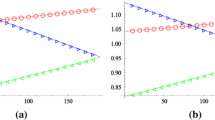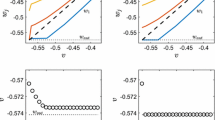Abstract
This paper is about (non) participation in efficient risk sharing among agents who have ambiguous beliefs about uncertain states of nature. The question we ask is whether and how can ambiguous beliefs give rise to some agents not participating in efficient risk sharing. Ambiguity of beliefs is described by the multiple-prior expected utility of Gilboa and Schmeidler (J Math Econ 18:141–153, 1989), or the variational preferences of Maccheroni et al. (Econometrica 74(6):1447–1498, 2006). The main result says that if the aggregate risk is relatively small, then the agents whose beliefs are the most ambiguous do not participate in risk sharing. The higher the ambiguity of those agents’ beliefs, the more likely is their non-participation. Another factor making non-participation more likely is low risk aversion of agents whose beliefs are less ambiguous. We discuss implications of our results on agents’ participation in trade in equilibrium in assets markets.
Similar content being viewed by others
Notes
Positive correlation is implied by comonotonicity, see LeRoy and Werner (2014, pg. 158).
We use the terms risk free and risky to mean, respectively, deterministic and non-deterministic consumption plans.
For completeness, we prove this result in Proposition 5 in the Appendix.
Multiple-prior expected utility with core of convex capacity as a set of priors has an equivalent representation as Choquet expected utility of Schmeidler (1989).
Our use of the standard concepts of the theory of aversion to risk should be taken with care. Those concepts have been developed in the setting of expected utility and their meaning for the multiple-prior expected utility may not be the same. For instance, linear utility v exhibits risk neutrality for expected utility, but this does not mean that the agent with multiple-prior expected utility is indifferent between the expectation of a consumption plan delivered with certainty and the consumption plan itself.
References
Araujo, A., Bonnisseau, J. M., Chateauneuf, A., & Novinski, R. (2017). Optimal sharing with an infinite number of commodities in the presence of optimistic and pessimistic agents. Economic Theory, 63, 131–157.
Billot, A., Chateauneuf, A., Gilboa, I., & Tallon, J.-M. (2000). Sharing beliefs: Between agreeing and disagreeing. Econometrica, 68(4), 685–694.
Cao, H. H., Wang, T., & Zhang, H. H. (2005). Model uncertainty, limited market participation and asset prices. Review of Financial Studies, 8, 1219–1251.
Chakravarty, S., & Kelsey, D. (2015). Sharing ambiguous risks. Journal of Mathematical Economics, 56, 1–8.
Chateauneuf, A., Dana, R. A., & Tallon, J. M. (2000). Risk sharing rules and equilibria with non-additive expected utilities. Journal of Mathematical Economics, 34, 191–214.
Dana, R. A. (2004). Ambiguity, uncertainty and equilibrium welfare. Economic Theory, 23, 569–587.
de Castro, L., & Chateauneuf, A. (2011). Ambiguity aversion and trade. Economic Theory, 48, 243–273.
Dominiak, A., Eichberger, J., & Lefort, J. (2012). Agreeable trade with pessimism and optimism. Mathematical Social Sciences, 64, 119–126.
Dow, J., & Werlang, S. (1992). Ambiguity aversion, risk aversion, and the optimal choice of portfolio. Econometrica, 60, 197–204.
Easley, D., & O’Hara, M. (2009). Ambiguity and nonparticipation: The role of regulation. Review of Financial Studies, 22, 593–624.
Ghirardato, P., & Marinacci, M. (2002). Ambiguity made precise: A comparative foundation. Journal of Economic Theory, 102, 251–289.
Ghirardato, P., & Siniscalchi, M. (2018). Risk sharing in the small and in the large. Journal of Economic Theory, 175, 730–765.
Gierlinger, J. (2018). Market completeness and ambiguity aversion. Working paper, Universitat Autonoma de Barcelona.
Gilboa, I., & Schmeidler, D. (1989). Maxmin expected utility with nonunique prior. Journal of Mathematical Economics, 18, 141–153.
Kajii, A., & Ui, T. (2006). Agreeable bets with multiple priors. Journal of Economic Theory, 128, 299–305.
Kajii, A., & Ui, T. (2009). Trade with heterogeneous multiple priors. Journal of Economic Theory, 144, 337–353.
Klibanoff, P., Marinacci, M., & Mukerji, S. (2005). A smooth model of decision making under ambiguity. Econometrica, 73(6), 1849–92.
LeRoy, S., & Werner, J. (2014). Principles of Financial Economics (2nd ed.). Cambridge: Cambridge University Press.
Maccheroni, F., Marinacci, M., & Rustichini, A. (2006). Ambiguity aversion, robustness, and the variational representation of preferences. Econometrica, 74(6), 1447–1498.
Martins-da-Rocha, V. F. (2010). Interim efficiency with MEU-preferences. Journal of Economic Theory, 145, 1987–2017.
Mukerji, S., & Tallon, J. M. (2001). Ambiguity aversion and incompleteness of financial markets. Review of Economic Studies, 68, 883–904.
Mukerji, S., & Tallon, J. M. (2004). Ambiguity aversion and the absence of indexed debt. Economic Theory, 24, 665–685.
Ozsoylev, H., & Werner, J. (2011). Liquidity and asset prices in rational expectations equilibrium with ambiguous information. Economic Theory, 48, 469–491.
Rigotti, L., Shannon, Ch., & Strzalecki, T. (2008). Subjective beliefs and ex-ante trade. Econometrica, 76, 1176–1190.
Rockafellar, T. (1970). Convex analysis. Princeton: Princeton University Press.
Schmeidler, D. (1989). Subjective probability and expected utility without additivity. Econometrica, 57, 571–587.
Strzalecki, T. (2011). Axiomatic foundations of multiplier preferences. Econometrica, 79(1), 47–73.
Strzalecki, T., & Werner, J. (2011). Efficient allocations under ambiguity. Journal of Economic Theory, 146, 1173–1194.
Author information
Authors and Affiliations
Corresponding author
Additional information
Publisher's Note
Springer Nature remains neutral with regard to jurisdictional claims in published maps and institutional affiliations.
Appendix
Appendix
For two probability measures \(P, Q \in \Delta ,\) let \(|P - Q|\) denote the total-variation distance between them. That is,
Further, let \(V_{\delta } (\mathcal{P}) \subset \Delta\) denote the \(\delta\)-neighborhood of the set \(\mathcal{P} \subset \Delta\) in the variational distance for \(\delta > 0.\) Let \({\hat{\omega }}= \max _s \omega _s\) and let \(\hat{A}_i = \sup \{A_i(x) : x \in [0, {\hat{\omega }}]\}\) where \(A_i(x) = - {v_i''(x) \over v_i'(x)}\) is the Arrow-Pratt measure of risk aversion.
Proof of Theorem 1
First we show the following lemma.
Lemma 2
If \(c \in B_{\epsilon }(D)\) and \(c \in R^S_{++},\) then \(Q_i(c) \subset V_{\delta } (\mathcal{P}_i)\) for \(\delta = e^{2 \epsilon \hat{A}_i} - 1.\)
Proof
Take any \(Q \in Q_i(c)\). Let \(P\in \mathcal{P}_i\) be such that \(Q(s) = {{v'_i(c(s)) P(s)} \over {\mathbf{E}_{P}[v'_i(c)]}}\) for every s. Further, let \({\underline{c}} = \min _s c_s\) and \({\bar{c}} = \max _s c_s.\) We have
Further,
where we used the fact that \(\bar{c} - {\underline{c}} \le 2 \epsilon\) for \(c \in B_{\epsilon }(D).\) Combining, we obtain
Therefore \(Q \in V_{\delta } (\mathcal{P}_i).\) \(\square\)
We proceed now with the proof of Theorem 1. Since \(\mathcal{P}_j \subset \mathrm{int} \mathcal{P}_k,\) there exists \(\delta\) be such that \(V_{\delta } (\mathcal{P}_j) \subset \mathrm{int} \mathcal{P}_k.\) Let \(\tilde{\epsilon }\) be such that \(e^{2 \tilde{\epsilon }\hat{A}_j} - 1 = \delta .\) By Lemma 2, \(Q_j(c_j) \subset \mathrm{int} \mathcal{P}_k\) for every \(c_j \in B_{\tilde{\epsilon }}(D).\) If \(c_j\) is part of an interior Pareto optimal allocation and \(Q_j(c_j) \subset \mathrm{int} \mathcal{P}_k\), then it follows from Proposition 1 and Lemma 1 (ii) that \(c_k\) is risk free. Hence, it suffices to show that there exists \(\epsilon > 0\), such that if \(\omega \in B_{\epsilon } (D),\) then \(c_j \in B_{\tilde{\epsilon }}(D)\) for every consumption plan \(c_j\) that is part of an interior Pareto optimal allocation.
Let \(\mathcal{E}_j(\omega )\) be the set of Pareto optimal consumption plans of agent j. Let \(b \in D\) be such that \(b> > \omega .\) Mapping \(\mathcal{E}_j(\cdot )\) is an upper hemi-continuous correspondence on the compact set [0, b]. Let \(\hat{D} = D \cap [0, b].\) By assumption (8), \(\mathcal{E}_j(\omega ) \subset \hat{D}\) if \(\omega \in \hat{D}.\) Therefore there exists \(\epsilon\) be such that if \(\omega \in B_{\epsilon } (\hat{D}),\) then \(\mathcal{E}_j(\omega ) \subset B_{\tilde{\epsilon }}(\hat{D}).\) This concludes the proof of Theorem 1. \(\square\)
Proof of Theorem 2
We start with a lemma.
Lemma 3
If \(\hat{A}_i < \epsilon ,\) then \(Q_i(c) \subset V_{\delta } (\mathcal{P}_i)\) for \(\delta = e^{\epsilon {\hat{\omega }}} -1\) and every \(c \in R^S_{++}\) such that \(c \le \omega .\)
Proof
The proof is similar to Lemma 2. For any \(Q \in Q_i(c)\) let \(P\in \mathcal{P}_i\) be such that \(Q(s) = {{v'_i(c(s)) P(s)} \over {\mathbf{E}_{P}[v'_i(c)]}}\) for every s. We have
Since
it follows that
Therefore \(Q \in V_{\delta } (\mathcal{P}_i)\) for \(\delta = e^{\epsilon {\hat{\omega }}} -1.\) \(\square\)
We proceed with the proof of Theorem 2. Since \(\mathcal{P}_j \subset \mathrm{int} \mathcal{P}_k,\) there exists \(\delta\) such that \(V_{\delta } (\mathcal{P}_j) \subset \mathrm{int} \mathcal{P}_k.\) Let \(\epsilon\) be such that \(e^{\epsilon {\hat{\omega }}} - 1 = \delta .\) If \(\hat{A}_j < \epsilon\) and \(c_j\) is part of an interior Pareto optimal allocation \(\{c_i\}\), then \(Q_j(c_j) \subset \mathrm{int} \mathcal{P}_k,\) where we used Lemma 3. Using Proposition 1 and Lemma 1 (ii) we obtain that \(c_k\) is risk free. \(\square\)
Proof of footnote 4 in Sect. 3:
Proposition 5
If \(int \bigcap _{i=1}^I \mathcal{P}_i \ne \emptyset\) and there is no aggregate risk, then every Pareto optimal allocation is risk free.
Proof
Let \(\{c_i\}\) be a feasible allocation. Let \(\pi \in \mathrm{int} \bigcap _{i=1}^I \mathcal{P}_i.\) For each i, let \(\hat{c}_i = E_{\pi }(c_i).\) Since \(\bar{\omega }\) is risk free, it follows that allocation \(\{\hat{c}_i\}\) is feasible. Inequality (7) implies that \(U_i(\hat{c}_i) \ge U_i(c_i),\) with strict inequality if \(c_i\) is risky. It follows that every Pareto optimal allocation is risk free. \(\square\)
Rights and permissions
About this article
Cite this article
Werner, J. Participation in risk sharing under ambiguity. Theory Decis 90, 507–519 (2021). https://doi.org/10.1007/s11238-020-09787-9
Accepted:
Published:
Issue Date:
DOI: https://doi.org/10.1007/s11238-020-09787-9




